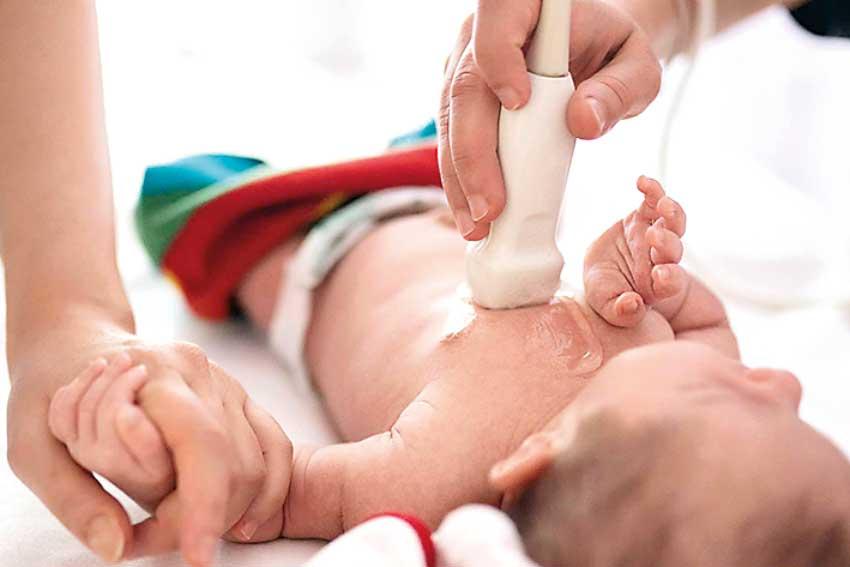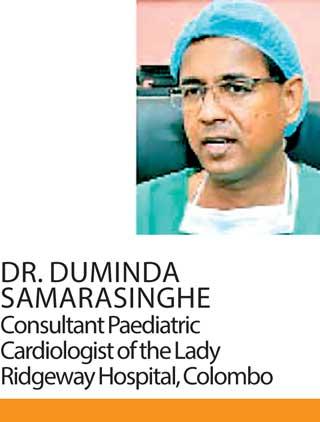Reply To:
Name - Reply Comment

 The news that one’s child suffers from a congenital heart condition would not sit well with any caring and loving parent because a child is the most precious gift they could ever ask for. Explaining the intricacies of congenital heart conditions Consultant Paediatric Cardiologist of the Lady Ridgeway Hospital for Children, Dr. Duminda Samarasinghe says that routine follow ups and early interventions are recommended to ensure a patient has a healthy lifestyle in the long run.
The news that one’s child suffers from a congenital heart condition would not sit well with any caring and loving parent because a child is the most precious gift they could ever ask for. Explaining the intricacies of congenital heart conditions Consultant Paediatric Cardiologist of the Lady Ridgeway Hospital for Children, Dr. Duminda Samarasinghe says that routine follow ups and early interventions are recommended to ensure a patient has a healthy lifestyle in the long run.
 In a brief explanation of common congenital heart diseases, Dr. Samarasinghe had the following to say, “As you are aware of the heart has four chambers. Blue blood or deoxygenated blood goes through the right side of the heart and the red blood or oxygenated blood goes through the left side. There are walls between these chambers to prevent mixing of blood. The commonest Congenital Heart Disease (CHD) is a hole between the two upper chambers of the heart, which is called an Atrial Septal Defect. The second commonest is a hole between the two lower chambers of the heart which is called a Ventricular Septal Defect.
In a brief explanation of common congenital heart diseases, Dr. Samarasinghe had the following to say, “As you are aware of the heart has four chambers. Blue blood or deoxygenated blood goes through the right side of the heart and the red blood or oxygenated blood goes through the left side. There are walls between these chambers to prevent mixing of blood. The commonest Congenital Heart Disease (CHD) is a hole between the two upper chambers of the heart, which is called an Atrial Septal Defect. The second commonest is a hole between the two lower chambers of the heart which is called a Ventricular Septal Defect.
“The other simpler and common lesions are narrowing of valves of the heart. All these lesions do not lead to bluish discolouration of the body. There are more complex lesions that will lead to bluish discolouration of the body. These are called cyanotic CHDs. Tetralogy of Fallot is the commonest lesion among them. TGA (Transposition of the great arteries) is another common cyanotic CHD”.
Diagnosis and Treatment
According to Dr. Samarasinghe, a CHD is first suspected based on the signs and symptoms of the child. Thereafter, the patient is referred to a paediatric cardiologist for an echocardiogram, where the final diagnosis is made. Selected patients are subjected to a diagnostic cardiac catheterisation to get additional information. Stating that not all patients with CHD need treatment, he added that out of those who need treatment, simpler lesions like a hole in the heart or narrowing of a blood vessel or a valve can be treated with a catheter intervention. However, more complex lesions and even some simpler lesions may need surgery. A very few patients are born with very complex lesions, which are beyond correction. Sometimes, until they go for surgery or catheter interventions, certain drugs are given to control symptoms. There are no drugs that can provide a cure for CHD.
Is CHD completely curable?
When inquired if CHD is completely curable, Dr. Samarasinghe noted that it is better to avoid the term ‘completely curable’. “Some of the simpler congenital heart diseases can be cured with proper treatment. However, more complex lesions, even after treatment can have some residual effects. Therefore, even after treatment, we need to follow them up as some of them can develop complications later in life. By providing early intervention for these complications, we can ensure normal life for these patients” he added.
As for the long term effects of CHD on a patient, it depends on the lesion. CHD covers a wide spectrum of diseases and most of the patients can lead a normal life after treatment. However, some may develop rhythm abnormalities later in life. Those who have residual lesions after treatment will have symptoms to varying degree depending on the effects of the residual lesion. Some may develop complications many years after surgery.
Take home message to parents
Stating that the most important factor in CHD is early suspicion and proper diagnosis, Dr. Samarasinghe noted that some lesions, if not diagnosed during early life, will become inoperable. Therefore, they need early diagnosis and appropriate treatment at proper age. “Those who are diagnosed to have a CHD, need to be followed up by a paediatric cardiologist. It is very important to follow the plan laid down for your child. If surgery or intervention is recommended, you need to follow the advice. Most problems occur because parents do not follow medical advice. They rely more on the advice given by neighbours over the advice given by a medical professional.
“It is also important to note that we as a country have facilities to treat only around 50% of the children with heart diseases and critical illnesses. Every year, approximately 1,500 children die in Sri Lanka due to congenital heart diseases and critical illnesses. Therefore, it is the responsibility of every citizen in Sri Lanka towards the Little Hearts project, which will help save these 1,500 children in the near future. Please direct all your donations to our account at Bank of Ceylon. Account name: Little Hearts. Account No: 79738633. For more information, please visit www.littlehearts.lk or call 0716441122,” Dr. Samarasinghe concluded.